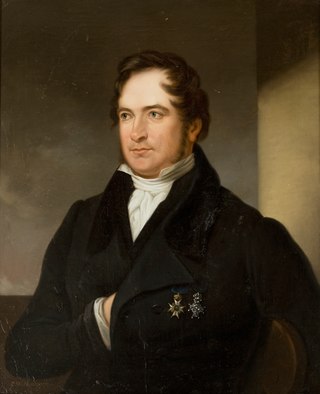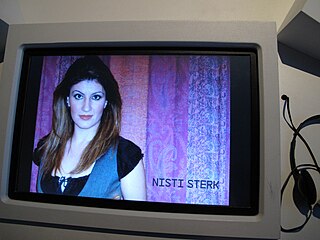Related Research Articles

Erik Gustaf Geijer was a Swedish writer, historian, poet, romantic critic of political economy, philosopher, and composer. His writings served to promote Swedish National Romanticism. He was an influential advocate of conservatism, but switched to liberalism later in life.
Sven Rydenfelt was a Swedish economist and political writer known for his libertarian views.
Margareta Hedvig Alströmer, as married Cronstedt af Fullerö, was a Swedish painter and concert singer. She was a member of the Royal Swedish Academy of Arts and of the Royal Swedish Academy of Music.

The title of riksspelman is a generally recognized badge of mastery for Swedish folk musicians. It is an honor bestowed upon bearers of the silver or gold Zorn Badge, awarded annually by the Zorn Jury, a panel of experts under the auspices of Svenska Folkdansringen. The silver Zorn Badge is the highest award attainable for musicians who play before the Zorn Jury in their annual Zorn Trials. The gold Zorn Badge cannot be sought, but is reserved for one or two master musicians pre-selected by the Jury.

The spelmanslag is an amateur organization of Swedish folk musicians, usually dominated by fiddles, who play tunes together. Often these groups play tunes from the specific area of Sweden with which they are affiliated. The term has also the same meaning for Norwegian folk music. Spelmanslag meetings tend to serve social function as much as they do musical ones; and money from paid performances generally goes to the group, rather than its constituent individuals.

A spelman is a player of Swedish folk music. The term has also the same meaning for Norwegian folk music, and corresponds directly to the term spillemand in Danish traditional music. Less often spelman may be folk musicians from other Nordic countries, from other European countries, from non-European countries, and even musicians in other genres. The meaning of the Swedish word spelman is very similar to that of the English "fiddler," except that it is not tied to a specific instrument. Because of the commonality of the fiddle in Swedish folk music, the word is often translated as fiddler in any case. Technically, the actual Swedish word for fiddler would be "fiolspelman".

Kari Valtteri Tarkiainen is a Finnish historian and archivist, who served as the national archivist of Finland 1996–2003. He is a grandson of the scholar Viljo Tarkiainen and his wife, writer Maria Jotuni.

Nisti Stêrk is a Swedish-Kurdish actress and comedian.
Jeanne-Élisabeth Le Clerc Soligny, known also under her stage name Elisabeth Le Clerc, was a French ballet mistress and ballerina. She was a premier dancer at the French Ballet of the Du Londel Troupe in Sweden and of the Royal Swedish Ballet.

Kerstin Thorvall was an influential Swedish novelist.

General Count Carl August Ehrensvärd was a Swedish Army officer. He was born in Karlskrona, and was son of the admiral and Minister for Naval Affairs, Carl August Ehrensvärd. Ehrensvärd left the Swedish Army in 1918 and joined the Finnish Army and saw action during the Finnish Civil War. Ehrensvärd rejoined the Swedish Army the same year and served until 1940 when he became general Ernst Linder's Chief of Staff during the Winter War as part of the Swedish Volunteer Corps. Back again in the Swedish Army, Ehrensvärd held positions such as Chief of the Defence Staff and Chief of the Army. He retired in 1957.

Josefina Leontina Amanda Wettergrund, née Lundberg pseudonym Lea, was a Swedish writer and poet. She was the editor of the family magazine Svalan in 1871–75.

The Swedish National Socialist Party was a Nazi political party in Sweden. Birger Furugård served as riksledare of the party.
Skinnar Per Andersson from Sollerön was a farmer from Dalarna, member of the Swedish Riksdag representing parts of Dalarna and one of the key leaders of the Dalecarlian Rebellion of 1743.
Nu ska vi sjunga was published in 1943 by the Almqvist & Wiksell publishing company, and is a songbook for Swedish primary schools. Songs marked with * are meant to be sung in the third grade. The book was published on the initiative of Alice Tegnér.

FACIT EDB was a vacuum tube based computer that was manufactured by Åtvidabergs Industrier AB after the designs for BESK, that had been developed by the Swedish Board for Computing Machinery (Matematikmaskinnämnden).
Ninon Dubois Le Clerc or Ninon Leclaire, was a French ballerina and courtesan. She was a member of the Royal Swedish Ballet and regarded as one of the stars of the royal ballet during her career there. As a courtesan she was known for her relationship with the Russian ambassador Ivan Simolin and the poet Johan Henric Kellgren, who wrote a poem in lamentation over her death in consumption.
Ernst Åke Kromnow was a Swedish archivist, historian and civil servant. He was National Archivist and head of the National Archives of Sweden from 1965 to 1979.

Yvonne Hirdman is a Swedish historian and gender researcher. She has received many awards for her work including the August Prize.
Koppången is a Swedish song, with music composed originally for violin in 1998 by Per-Erik Moraeus for his folk music group Orsa Spelmän, which includes his brothers Kalle Moraeus and Olle Moraeus. The name and the inspiration for the song come from the wetlands and nature preserve Koppången, near the Moraeus family home in Orsa Municipality, Dalarna, Sweden.
References
- Ivarsdotter-Jonsson, Anna (1992). "Upptäckten av folkmusiken." In Musiken i Sverige III, edited by Leif Jonsson and Martin Tegen, 53-70. Stockholm: Fischer & Co. (in Swedish)
- Ivarsdotter-Jonsson, Anna, and Märta Ramsten (1992). "Folkmusiken som nationell och provinsiell symbol." In Musiken i Sverige III, edited by Leif Jonsson and Martin Tegen, 237-250. Stockholm: Fischer & Co. (in Swedish)
- Jersild, Margareta (1976). "Om förhållandet mellan vokalt och instrumentalt i svensk folkmusik. Svensk tidskrift för musikforskning 58(2): 53-66. (in Swedish)
- Kaminsky, David (2005). "Hidden Traditions: Conceptualizing Swedish Folk Music in the Twenty-First Century." Ph.D. Dissertation, Harvard University.
- Ling, Jan (1980). "'Upp, Bröder, Kring Bildningens Fana:' Om Folkmusikens Historia och Ideologi." In Folkmusikboken, edited by Jan Ling, et al., 44-65. Stockholm: Prisma: 11-43. (in Swedish)
- Ramsten, Märta (1979). "Sveriges Radio, Matts Arnberg, och Folkmusiken." Fataburen 1979: 127-158. (in Swedish)
- Ramsten, Märta (1992). Återklang: Svensk Folkmusik i Förändring 1950-1980. Stockholm: Svenskt Visarkiv. (in Swedish)
- Roempke, Ville (1980). "'Ett nyår för svensk folkmusik:' Om spelmansrörelsen." In Folkmusikboken, edited by Jan Ling, et al., 263-296. Stockholm: Prisma. (in Swedish)
- Ternhag, Gunnar (1980). "'Att rädda några dyrbara lemningar af fordna tiders musik:' Om folkmusikens källor." In Folkmusikboken, edited by Jan Ling, et al., 44-65. Stockholm: Prisma. (in Swedish)